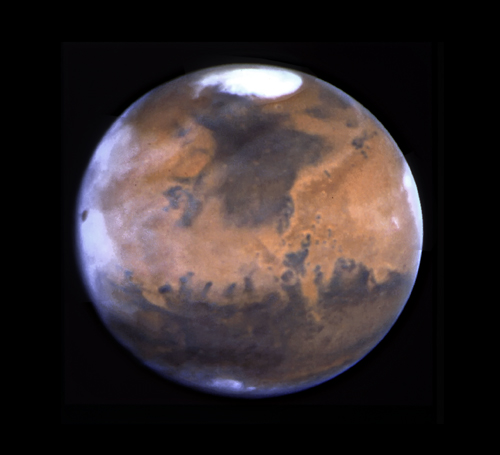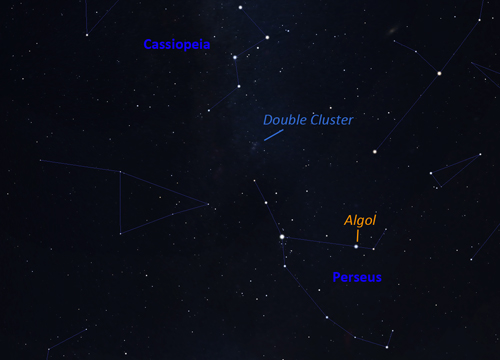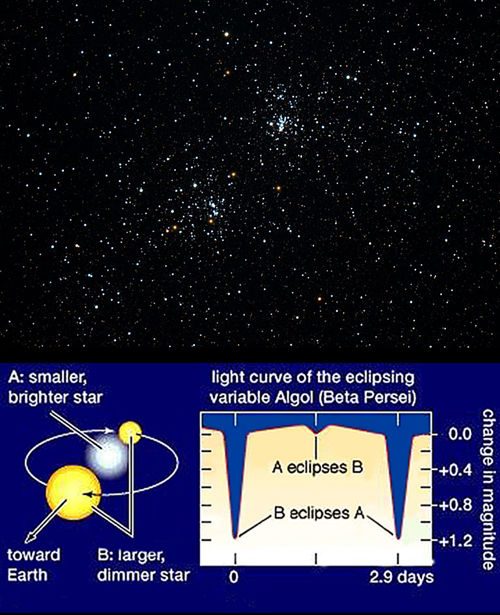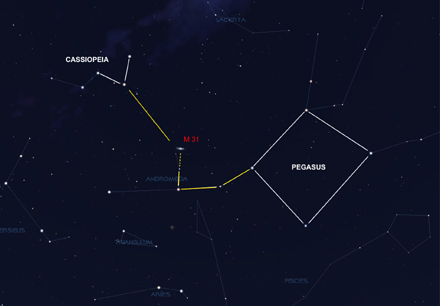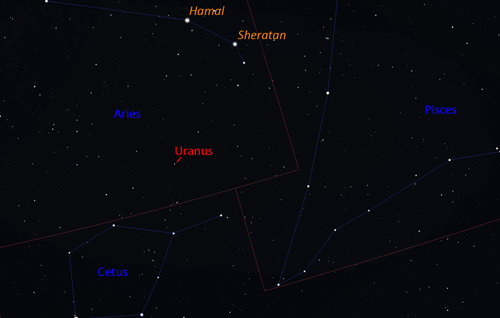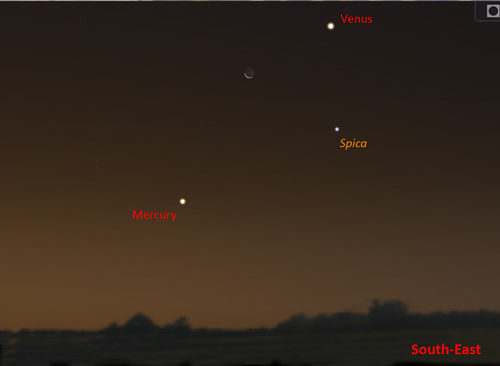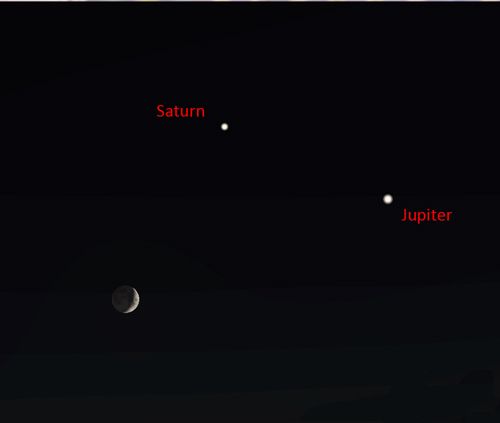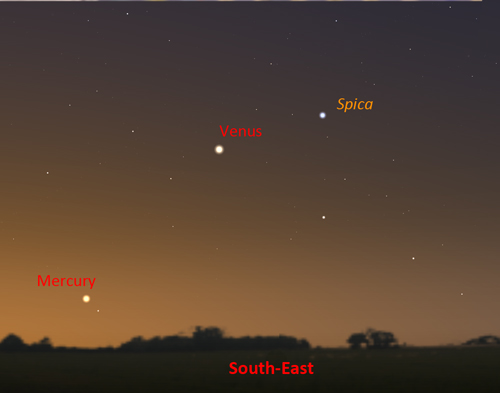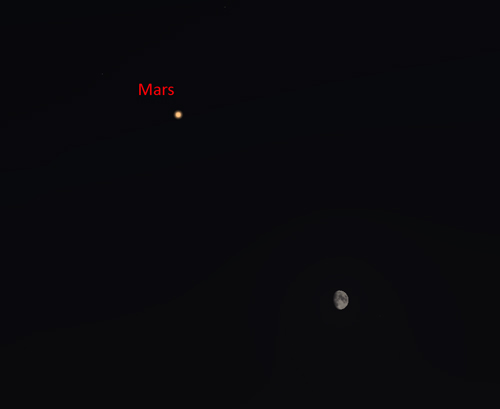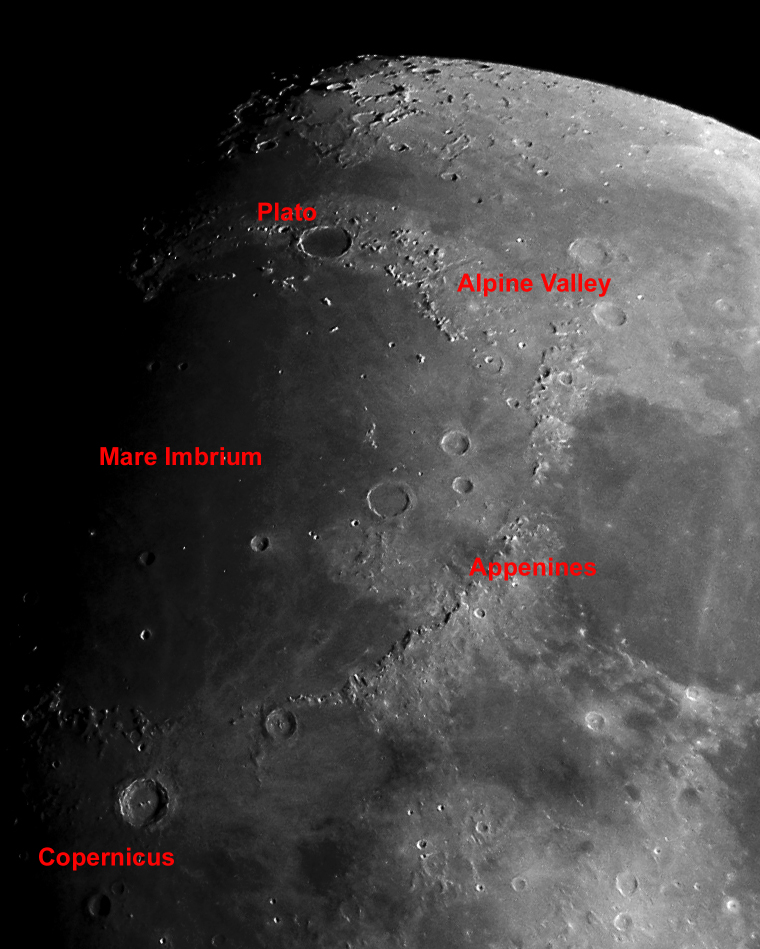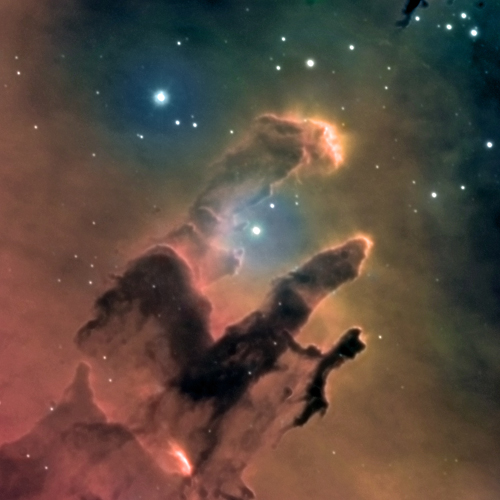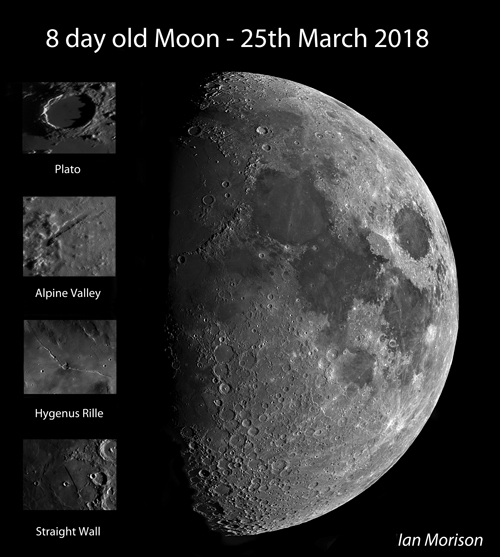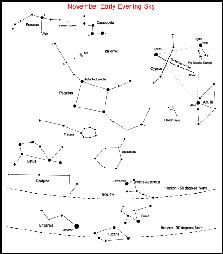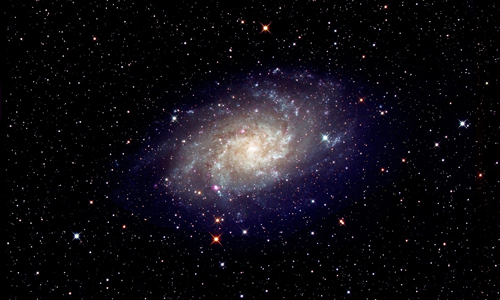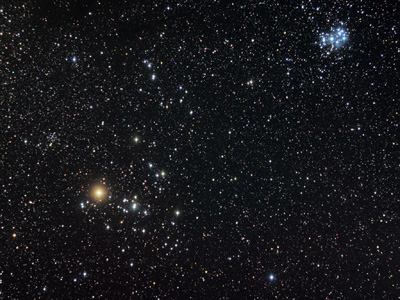The Night Sky November 2020
Compiled by Ian Morison
This page, updated monthly, will let you know some of the things that you can look out for in the night sky. It lists the phases of the Moon, where you will see the naked-eye planets and describes some of the prominent constellations in the night sky during the month.
New(ish)
The author's: Astronomy Digest
which, over time, will provide useful and, I hope, interesting articles for all amateur astronomers. A further aim is to update and add new material to link with the books recently published by Cambridge University Press and which are described on the home page of the digest. It now includes nearly 100 illustrated articles.Image of the Month
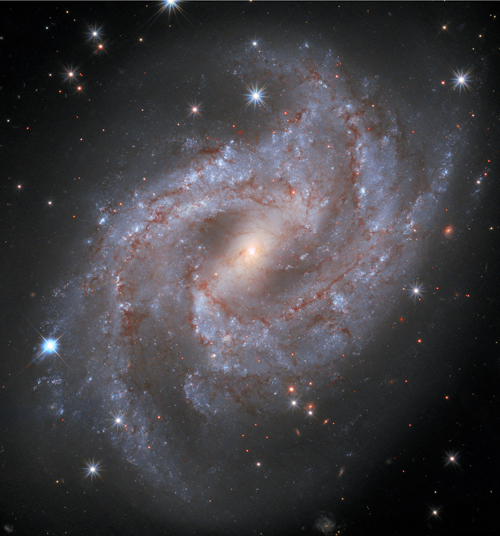
Supernova in Spiral Galaxy, NGC 2525
This is an HST image of the galaxy NGC 2525 which lies some 70 million miles away in the constellation Puppis. It is about 60,000 light years across and its spiral arms contain dark dust clouds, star forming regions and young massive blue stars. To the lower left of the image, taken in January 2018, can be seen the Type Ia Supernova, SN2018gv, which resulted from the nuclear detonation of a white dwarf star triggered by the accretion of material from its companion star. It is believed that all Type Ia supernova have a similar peak brightness so are termed 'standard candles' and so can be used to meaure the distances of remote galaxies. Combined with their recession velocities, this allows a measure of the expanison rate of the Universe - which, interestingly, does not quite agree with that obtained by observations of the Cosmic Microwave Background.
Highlights of the Month
Early November - still a good time to view Mars.
This is still a great month to observe Mars which had its closest approach to Earth on October the 6th when it will lay 39 million miles from Earth and reached opposition on the 13th so the highest in the south around late evening. Wonderfully, at this opposition, Mars is far higher in the sky than at recent oppositions. In Pisces, Mars, outshining even Jupiter at the start of the month, can be seen rising in the east at sunset at the start of November. It crosses the meridian at 22:30 GMT on the 1st of the month and at 20:30 GMT by month's end. Its magnitude as November begins is -2.1 and fades to -1.2 by the end of the month. Its angular size is just over 20 arc seconds at the start of the month dropping to 14,8 arc seconds by month's end. Reaching an elevation of ~43 degrees when due south as seen from the UK, amateur telescopes will enable one to see features, such as Syrtis Major, on its surface when the seeing conditions are good. This is the best time to observe Mars until 2035!
During this opposition, Mar's southern hemisphere is tipped towards the Earth and so the South Polar Cap should be visible, though much of its frozen carbon dioxide will have vaporised during the Martian summer. Though the North Polar Cap is beyond our view, one should be able to spot the haze of the North Polar Hood lying above the northern limb of the planet. At 24.6 hours long, the Martian day is similar to ours, so the surface details remain similar at the same time each night.
Mars takes 41 days to make an apparent rotation as seen from Earth.
November early mornings: November Meteors.
In the hours before dawn, November gives us a chance to observe meteors from two showers. The first that it is thought might produce some bright events is the Northern Taurids shower which has a broad peak of around 10 days but normally gives relatively few meteors per hour. The peak is around the 10th of November when the Moon is two days after third quarter so its light may intrude. The meteors arise from comet 2P/Encke. Its tail is especially rich in large particles and, this year, we may pass through a relatively rich band so it is possible that a number of fireballs might be observed!
The better known November shower is the Leonids which peak on the night of the 17th/18th of the month. The Moon is just after new and will have set well before midnight so its light will not hinder our view and so enable the fainter meteors to be seen. As one might expect, the shower's radiant lies within the sickle of Leo and meteors could be spotted from the 15th to the 20th of the month. The Leonids enter the atmosphere at ~71 km/sec and this makes them somewhat challenging to photograph but its worth trying as one might just capture a bright fireball. Up to 15 meteors an hour could be observed if near the zenith. The Leonids are famous becaus every 33 years a meteor storm might be observed when the parent comet, 55P/Temple-Tuttle passes close to the Sun. In 1999, 3,000 meteors were observed per hour but we are now halfway between these impressive events hence a far lower rate is expected.November, evening: the Double Cluster and the 'Demon Star', Algol.
This month, in the evening, is a good time to look high in the east towards the constellations of Cassiopea and Perseus. Perseus contains two interesting objects; the Double Cluster between the two constellations and Algol the 'Demon Star'. Algol in an eclipsing binary system as seen in the diagram below. Normally the pair has a steady magnitude of 2.2 but every 2.86 days this briefly drops to magnitude 3.4.
November: find M31 - The Andromeda Galaxy - and perhaps M33 in Triangulum
In the late evenings when the Moon is not prominent, the galaxy M31 in Andromeda will be visible high in the southeast. The chart provides two ways of finding it:
1) Find the square of Pegasus. Start at the top left star of the square - Alpha Andromedae - and move two stars to the left and up a bit. Then turn 90 degrees to the right, move up to one reasonably bright star and continue a similar distance in the same direction. You should easily spot M31 with binoculars and, if there is a dark sky, you can even see it with your unaided eye. The photons that are falling on your retina left Andromeda well over two million years ago!
2) You can also find M31 by following the "arrow" made by the three rightmost bright stars of Cassiopeia down to the lower right as shown on the chart.
Around new Moon (15th November) - and away from towns and cities - you may also be able to spot M33, the third largest galaxy after M31 and our own galaxy in our Local Group of galaxies. It is a face on spiral and its surface brightness is pretty low so a dark, transparent sky will be needed to spot it using binoculars (8x40 or, preferably, 10x50). Follow the two stars back from M31 and continue in the same direction sweeping slowly as you go. It looks like a piece of tissue paper stuck on the sky just a bit brighter than the sky background. Good Hunting!
November: find Uranus.
This month is a good time to find the planet Uranus in the late evening as it reached opposition on October 31st. With a magnitude of 5.7, binoculars will easily spot it and, from a really dark site, it might even be visible to the unaided eye. A medium aperture telescope will reveal Uranus's 3.7 arc second wide disk showing its turquoise colour. It lies in Aries, close to the boarder of Cetus as shown on the chart.
November 13th - 1 hour before sunrise - Venus, Mercury and Spica and a thin crescent Moon.
Before dawn on the 13th of November there will be a very nice grouping of the planets Mercury and Venus along with a very thin crescent Moon and Spica, Alpha Virginis.
November 19th - evening: Saturn,Jupiter and a waxing crescent Moon.
After sunset on the 19th of the month, a waxing crescent Moon could be seen, if clear, below Saturn and Jupiter.
November 22nd - before dawn : Venus, Mercury and Spica.
Before dawn on the 22nd, first Venus and then Mercury will lie down to the lower left of Spica, Alpha Virginis.
November 25th - after sunset : Mars lies up to the left of the Moon
After sunset on the 25th, Mars will be seen above a waxing Moon between third quarter and full.
November 8th and 24th: The Alpine Valley
An interesting valley on the Moon: The Alpine Valley
These are two good nights to observe an interesting feature on the Moon if you have a small telescope. Close to the limb is the Appenine mountain chain that marks the edge of Mare Imbrium. Towards the upper end you should see the cleft across them called the Alpine valley. It is about 7 miles wide and 79 miles long. As shown in the image is a thin rill runs along its length which is quite a challenge to observe. The dark crater Plato will also be visible nearby. You may also see the shadow cast by the mountain Mons Piton lying not far away in Mare Imbrium. This is a very interesting region of the Moon!
M16, the Eagle nebula, imaged with the Faulkes Telescope
The Eagle Nebula, M16, imaged by Daniel Duggan.
This image was taken using the Faulkes Telescope North by Daniel Duggan - for some time a member of the Faulkes telescope team. It is a region of dust and gas where stars are now forming. The ultraviolet light from young blue stars is stripping the electrons from hydrogen atoms so this region contains ionized hydrogen and is called an HII region. As the electrons drop back down through the hydrogen energy levels as the atoms re-form, red light at the H alpha wavelength is emitted. This "true colour" image is composed of red, green and blue images along with a narrow band H alpha image. A Hubble image of the central region, called the "Pillars of Creation", has become quite famous but looks green/blue in colour. This is a false colour image where the H alpha image has been encoded as green!
Learn more about the Faulkes Telescopes and how schools can use them: Faulkes Telescope"
Observe the International Space Station

The International Space Station and Jules Verne passing behind the Lovell Telescope on April 1st 2008.
Image by Andrew Greenwood
Use the link below to find when the space station will be visible in the next few days. In general, the space station can be seen either in the hour or so before dawn or the hour or so after sunset - this is because it is dark and yet the Sun is not too far below the horizon so that it can light up the space station. As the orbit only just gets up the the latitude of the UK it will usually be seen to the south, and is only visible for a minute or so at each sighting. Note that as it is in low-earth orbit the sighting details vary quite considerably across the UK. The NASA website linked to below gives details for several cities in the UK. (Across the world too for foreign visitors to this web page.)
Note: I observed the ISS three times recently and was amazed as to how bright it has become.
Find details of sighting possibilities from your location from: Location Index
See where the space station is now: Current Position
The Moon

The Moon at 3rd Quarter. Image, by Ian Morison, taken with a 150mm Maksutov-Newtonian and Canon G7.
Just below the crator Plato seen near the top of the image is the mountain "Mons Piton". It casts a long shadow across the maria from which one can calculate its height - about 6800ft or 2250m.
| new moon | first quarter | full moon | third quarter |
|---|---|---|---|
| November 15th | November 22nd | November 30th | November 8th |
Some Lunar Images by Ian Morison, Jodrell Bank Observatory: Lunar Images
A World Record Lunar Image
To mark International Year of Astronomy, a team of British astronomers have made the largest lunar image in history and gained a place in the Guinness Book of Records! The whole image comprises 87.4 megapixels with a Moon diameter of 9,550 pixels. The resolution of ~0.4 arc seconds allows details as small as 1km across to be discerned! The superb quality of the image is shown by the detail below of Plato and the Alpine Valley. Craterlets are seen on the floor of Plato and the rille along the centre of the Alpine valley is clearly visible. The image quality is staggering! The team of Damian Peach, Pete lawrence, Dave Tyler, Bruce Kingsley, Nick Smith, Nick Howes, Trevor Little, David Mason, Mark and Lee Irvine with technical support from Ninian Boyle captured the video sequences from which 288 individual mozaic panes were produced. These were then stitched together to form the lunar image.
Please follow the link to the Lunar World Record website and it would be really great if you could donate to Sir Patrick Moore's chosen charity to either download a full resolution image or purchase a print.
The 8 day old Moon
This image was taken by the author on a night in March 2018 when the Moon was at an elevation of ~52 degrees and the seeing was excellent. This enabled the resolution of the image to be largely determined by the resolution of the 200 mm aperture telescope and the 3.75 micron pixel size of the Point Grey Chameleon 1.3 megapixel video camera. The use of a near infrared filter allowed imaging to take place before it was dark and also reduced the effects of atmospheric turbulence. The 'Drizzle' technique developed by the Hubble Space Telescope Institute (HSTI) was used to reduce the effective size of the camera's pixels to allow the image to be well sampled. Around 100 gigabytes of data, acquired over a 2 hour period, was processed to produce images of 54 overlapping areas of the Moon which were then combined to give the full lunar disk in the free 'stitching' program Microsoft ICE. A further HSTI development called 'deconvolution sharpening' was then applied to the image. The Moon's disk is ~6,900 pixels in height and has a resolution of 0.6 to 0.7 arc seconds. Interestingly, as seen in the inset image, the rille lying along the centre of the Alpine Valley is just discernable and this is only ~0.5 km wide! [Due to size limitations the large image is 2/3 full size.]
The Planets
Jupiter
Jupiter along with Saturn still remains visible, low in the sky, just west of south when darkness falls as November begins and sets around 20:30 pm GMT. Towards the end of the month it will be seen towards the southwest after sunset and sets by ~19:00 pm GMT. Its magnitude dims slightly from -2.2 to -2.0 during the month whilst its angular diameter falls from 37.0 to 34.5 arc seconds. Sadly, even when first seen after sunset, it will only have an elevation of ~14 degrees above the horizon so the atmosphere will limit our views. Due its position in the most southerly part of the ecliptic this has been a very poor opposition for those of us in the northern hemisphere.
Saturn
Saturn. Following Jupiter into the sky, some 5.1 degrees behind at the start of the month but reducing to just 2.3 degrees by month's end, Saturn is best seen in the south just after sunset on the 1st. Its magnitude remains steady at +0.6 whilst its angular size decreases from 16.3 to 15.7 arc seconds. The rings span some 35 arc seconds across and, at ~22 degrees to the line of sight, show up well. Saturn lies in Sagittarius near the border of Capricornus. As the year progresses, Saturn becomes closer to Jupiter until, on the 21st December they are just 0.1 degrees apart. Sadly again, its low elevation of ~16 degrees when crossing the meridian will somewhat limit our views of this most beautiful planet.
Mercury
Mercury is visible all month in the pre-dawn sky, shining initially with a magnitude of +1.6 and rises over an hour before the Sun when its 21% illuminated disk has a diameter of 8.6 arc seconds. As the month progresses, its its apparent size decreases to 5 arc seconds but, as its phase (the percentage illuminated disk) has increased from 14% to 95%, its magnitude actually increases to -0.7. Mercury reaches greatest elongation west on the 10th of November shining at magnitude -0.6 and still rises an hour before the Sun by month's end.
Mars
Mars: See highlight above.
Venus
Venus, still dominates the pre-dawn sky rising around three hours before sunrise as November begins and half an hour less by month's end. It shines at magnitude -4 as November begins, dropping fractonally to -3.9 by the 11th for the remainder of the month whilst its angular size shrinks from 13.1 to 11.7 arc seconds. During the same time its its phase (the illuminated percentage of the disk) increases from 81% to 88% which is why the fall in magnitude is so small. It still reaches an elevation of ~21 degrees at sunrise at the start of the month. For the majority of the month, Venus lies in Virgo but moves into Libra on the 23rd.
The Stars
The Evening November Sky
This map shows the constellations seen towards the south in early evening. To the south in early evening moving over to the west as the night progresses is the beautiful region of the Milky Way containing both Cygnus and Lyra. Below is Aquilla. The three bright stars Deneb (in Cygnus), Vega (in Lyra) and Altair (in Aquila) make up the "Summer Triangle". East of Cygnus is the great square of Pegasus - adjacent to Andromeda in which lies M31, the Andromeda Nebula. To the north lies "w" shaped Cassiopeia and Perseus. The constellation Taurus, with its two lovely clusters, the Hyades and Pleiades is rising in the east during the late evening.
The constellations Lyra and Cygnus
This month the constellations Lyra and Cygnus are seen almost overhead as darkness falls with their bright stars Vega, in Lyra, and Deneb, in Cygnus, making up the "summer triangle" of bright stars with Altair in the constellation Aquila below. (see sky chart above)
Lyra
Lyra is dominated by its brightest star Vega, the fifth brightest star in the sky. It is a blue-white star having a magnitude of 0.03, and lies 26 light years away. It weighs three times more than the Sun and is about 50 times brighter. It is thus burning up its nuclear fuel at a greater rate than the Sun and so will shine for a correspondingly shorter time. Vega is much younger than the Sun, perhaps only a few hundred million years old, and is surrounded by a cold,dark disc of dust in which an embryonic solar system is being formed!
There is a lovely double star called Epsilon Lyrae up and to the left of Vega. A pair of binoculars will show them up easily - you might even see them both with your unaided eye. In fact a telescope, provided the atmosphere is calm, shows that each of the two stars that you can see is a double star as well so it is called the double double!
Between Beta and Gamma Lyra lies a beautiful object called the Ring Nebula. It is the 57th object in the Messier Catalogue and so is also called M57. Such objects are called planetary nebulae as in a telescope they show a disc, rather like a planet. But in fact they are the remnants of stars, similar to our Sun, that have come to the end of their life and have blown off a shell of dust and gas around them. The Ring Nebula looks like a greenish smoke ring in a small telescope, but is not as impressive as it is shown in photographs in which you can also see the faint central "white dwarf" star which is the core of the original star which has collapsed down to about the size of the Earth. Still very hot this shines with a blue-white colour, but is cooling down and will eventually become dark and invisible - a "black dwarf"! Do click on the image below to see the large version - its wonderful!
M56 is an 8th magnitude Globular Cluster visible in binoculars roughly half way between Albireo (the head of the Swan) and Gamma Lyrae. It is 33,000 light years away and has a diameter of about 60 light years. It was first seen by Charles Messier in 1779 and became the 56th entry into his catalogue.
Cygnus
Cygnus, the Swan, is sometimes called the "Northern Cross" as it has a distinctive cross shape, but we normally think of it as a flying Swan. Deneb,the arabic word for "tail", is a 1.3 magnitude star which marks the tail of the swan. It is nearly 2000 light years away and appears so bright only because it gives out around 80,000 times as much light as our Sun. In fact if Deneb where as close as the brightest star in the northern sky, Sirius, it would appear as brilliant as the half moon and the sky would never be really dark when it was above the horizon!
The star, Albireo, which marks the head of the Swan is much fainter, but a beautiful sight in a small telescope. This shows that Albireo is made of two stars, amber and blue-green, which provide a wonderful colour contrast. With magnitudes 3.1 and 5.1 they are regarded as the most beautiful double star that can be seen in the sky.
Cygnus lies along the line of the Milky Way, the disk of our own Galaxy, and provides a wealth of stars and clusters to observe. Just to the left of the line joining Deneb and Sadr, the star at the centre of the outstretched wings, you may, under very clear dark skys, see a region which is darker than the surroundings. This is called the Cygnus Rift and is caused by the obscuration of light from distant stars by a lane of dust in our local spiral arm. the dust comes from elements such as carbon which have been built up in stars and ejected into space in explosions that give rise to objects such as the planetary nebula M57 described above.
There is a beautiful region of nebulosity up and to the left of Deneb which is visible with binoculars in a very dark and clear sky. Photographs show an outline that looks like North America - hence its name the North America Nebula. Just to its right is a less bright region that looks like a Pelican, with a long beak and dark eye, so not surprisingly this is called the Pelican Nebula. The photograph below shows them well.
Brocchi's Cluster An easy object to spot with binoculars in Gygnus is "Brocchi's Cluster", often called "The Coathanger",although it appears upside down in the sky! Follow down the neck of the swan to the star Albireo, then sweep down and to its lower left. You should easily spot it against the dark dust lane behind.
The constellations Pegasus and Andromeda
Pegasus
The Square of Pegasus is in the south during the evening and forms the body of the winged horse. The square is marked by 4 stars of 2nd and 3rd magnitude, with the top left hand one actually forming part of the constellation Andromeda. The sides of the square are almost 15 degrees across, about the width of a clentched fist, but it contains few stars visibe to the naked eye. If you can see 5 then you know that the sky is both dark and transparent! Three stars drop down to the right of the bottom right hand corner of the square marked by Alpha Pegasi, Markab. A brighter star Epsilon Pegasi is then a little up to the right, at 2nd magnitude the brightest star in this part of the sky. A little further up and to the right is the Globular Cluster M15. It is just too faint to be seen with the naked eye, but binoculars show it clearly as a fuzzy patch of light just to the right of a 6th magnitude star.
Andromeda
The stars of Andromeda arc up and to the left of the top left star of the square, Sirra or Alpha Andromedae. The most dramatic object in this constellation is M31, the Andromeda Nebula. It is a great spiral galaxy, similar to, but somewhat larger than, our galaxy and lies about 2.5 million light years from us. It can be seen with the naked eye as a faint elliptical glow as long as the sky is reasonably clear and dark. Move up and to the left two stars from Sirra, these are Pi amd Mu Andromedae. Then move your view through a rightangle to the right of Mu by about one field of view of a pair of binoculars and you should be able to see it easily. M31 contains about twice as many stars as our own galaxy, the Milky Way, and together they are the two largest members of our own Local Group of about 3 dozen galaxies.
M33 in Triangulum
If, using something like 8 by 40 binoculars, you have seen M31 as described above, it might well be worth searching for M33 in Triangulum. Triangulum is
the small faint constellation just below Andromeda. Start on M31, drop down to Mu Andromedae and keep on going in the same direction by the same distance as you have moved from M31 to Mu Andromedae. Under excellent seeing conditions (ie., very dark and clear skies) you should be able to see what looks like a little piece of tissue paper stuck on the sky or a faint cloud. It appears to have uniform brightness and shows no structure. The shape is irregular in outline - by no means oval in shape and covers an area about twice the size of the Moon. It is said that it is just visible to the unaided eye, so it the most distant object in the Universe that the eye can see. The distance is now thought to be 3.0 Million light years - just greater than that of M31.
The constellation Taurus
Taurus is one of the most beautiful constellations and you can almost imagine the Bull charging down to the left towards Orion. His face is delineated by the "V" shaped cluster of stars called the Hyades, his eye is the red giant star Aldebaran and the tips of his horns are shown by the stars beta and zeta Tauri. Although alpha Tauri, Aldebaran, appears to lie amongst the stars of the Hyades cluster it is, in fact, less than half their distance lying 68 light years away from us. It is around 40 times the diameter of our Sun and 100 times as bright.
More beautiful images by Alson Wong : Astrophotography by Alson Wong
To the upper right of Taurus lies the open cluster, M45, the Pleiades. Often called the Seven Sisters, it is one of the brightest and closest open clusters. The Pleiades cluster lies at a distance of 400 light years and contains over 3000 stars. The cluster, which is about 13 light years across, is moving towards the star Betelgeuse in Orion. Surrounding the brightest stars are seen blue reflection nebulae caused by reflected light from many small carbon grains. These relfection nebulae look blue as the dust grains scatter blue light more efficiently than red. The grains form part of a molecular cloud through which the cluster is currently passing. (Or, to be more precise, did 400 years ago!)
Close to the tip of the left hand horn lies the Crab Nebula, also called M1 as it is the first entry of Charles Messier's catalogue of nebulous objects. Lying 6500 light years from the Sun, it is the remains of a giant star that was seen to explode as a supernova in the year 1056. It may just be glimpsed with binoculars on a very clear dark night and a telescope will show it as a misty blur of light.
Its name "The Crab Nebula" was given to it by the Third Earl of Rosse who observed it with the 72 inch reflector at Birr Castle in County Offaly in central Ireland. As shown in the drawing above, it appeared to him rather lile a spider crab. The 72 inch was the world's largest telelescope for many years. At the heart of the Crab Nebula is a neutron star, the result of the collapse of the original star's core. Although only around 20 km in diameter it weighs more than our Sun and is spinning 30 times a second. Its rotating magnetic field generate beams of light and radio waves which sweep across the sky. As a result, a radio telescope will pick up very regular pulses of radiation and the object is thus also known a Pulsar. Its pulses are monitored each day at Jodrell Bank with a 13m radio telescope.


